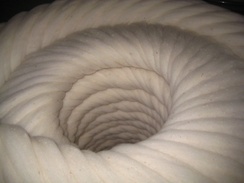Monday, January 14, 2013
A little Alpaca History

Beautiful alpaca tops
Alpacas 101: A Little History by Kern Deschner
In the early 1800’s, entrepreneurs were exporting sheep wool from Peru to the British textile mills. The importers in Portsmouth became fascinated with the incredible material used to make the sacks for shipping the wool. They found the source to be alpacas high in the Andes. Since the South Americans used most of the alpaca fiber, the little that was allowed for Europe was highly treasured and started a high-end fabric industry still growing today.
Alpacas have been domesticated for several thousand years, originating from the Vicunas that still are wild in the Patagonia. Surviving on some of the worst forage in the world, alpacas were a kind of domesticated “South American Buffalo”. They were used for meat (dried alpaca meat may be the source of the word “jerky”), and the fiber. The mummies of the ancient royalty were wrapped in alpaca fiber of a fineness rarely matched today. When the Spaniards conquered the Patagonia, subjugating the natives was achieved partially by killing their alpacas. The alpacas that escaped went in the mountains, and were considered extinct by the outside world until the British found the sacks. As recently as this last century, Peruvian terrorist bands would punish uncooperative villages by slaughtering their alpacas. For now, alpacas have experienced resurgence in Peru, Bolivia, and Chile, and have been exported to thriving colonies in Australia, Canada, and the United States.
Alpacas are shorn once a year for their extraordinary fleece. They are gregarious herd animals, known for their gentleness, alertness, and curiosity. Alpacas have one offspring, known as a “cria”, per year. Alpacas do not have mates, and breeding only occurs when the female (dam) is receptive to an available male. Gestation is nearly a year and females may stay pregnant most of their lives. Relatively defenseless, alpacas can only run from a predator. The alpaca’s one nasty habit, the infamous “spitting”, is uncommon and is usually directed at another alpaca. Unwary humans may get caught in the crossfire but experience teaches alpaca ranchers to know when to stay clear. An alpaca’s overall “cuteness”, however, is its’ most infectious quality.
BIO: Rhonda and Kern Deschner are experienced alpaca ranchers raising alpacas through all kinds of Texas weather since 1997. Tierra Prometida Alpaca Ranch, found on FM32 near the Devils Backbone rest stop, can be visited by calling Rhonda at 512-753-9962, or at
[email protected].